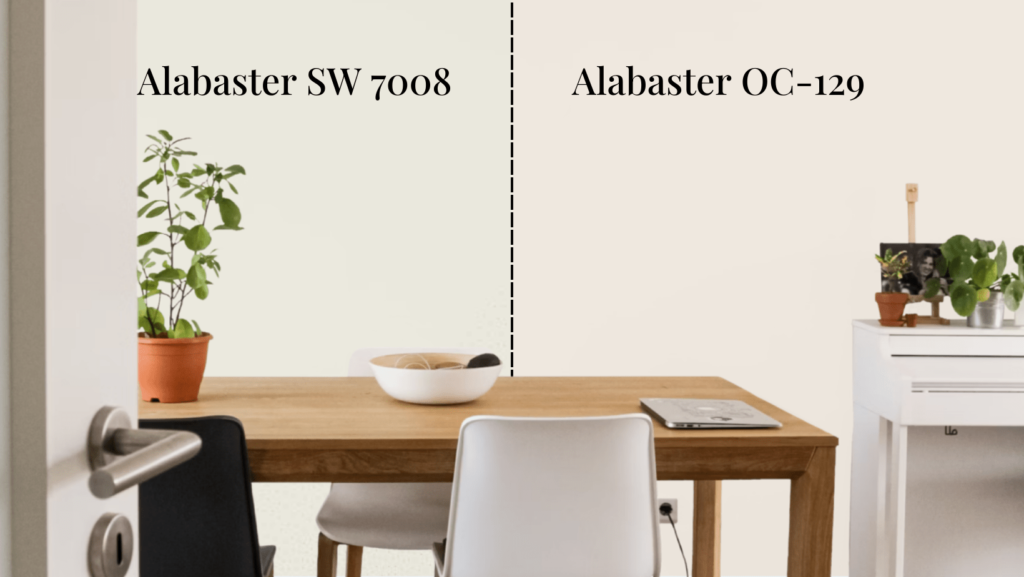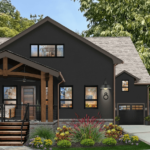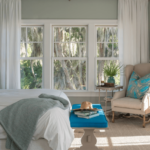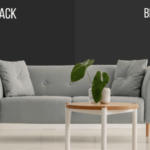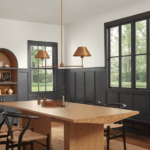Is Sherwin Williams Alabaster same as Benjamin Moore Alabaster?
Is your Pinterest board overflowing with soft, creamy whites? Do you struggle to pick the perfect shade? You’re not alone. “Alabaster” is one of the most beloved paint colors for homeowners, interior designers, and stagers alike—but here’s the twist. Two major paint brands, Sherwin Williams and Benjamin Moore, have their own versions of Alabaster. While they share a name, the colors aren’t identical.So the question arise Is Sherwin Williams Alabaster same as Benjamin Moore Alabaster?
This blog discusses the differences between Sherwin Williams Alabaster (SW 7008) and Benjamin Moore Alabaster (OC-129). Whether you’re painting your walls, cabinets, or trims, you’ll get the clarity you need to choose the right one for your home. Emily Peters, an interior designer, shares her thoughts on Sherwin Williams Alabaster, describing it as a
“timeless hue that effortlessly marries modern and traditional design aesthetics, making it a top choice for many of my projects.”
Home stylist Michael Chang praises Benjamin Moore Alabaster for its
“level of warmth and sophistication that is unmatched, creating a serene backdrop for any space.”
His insight underscores the tranquil quality that this shade brings to interiors.
What is Alabaster?
“Alabaster isn’t just white—it’s an invitation,” says Joanna Gaines, the queen of modern farmhouse design. And she’s absolutely right. Alabaster is a warm, creamy shade of white with subtle undertones that make it versatile and inviting.
Named after the natural mineral Alabaster, this color is often associated with purity and softness. That’s why it’s a favorite for spaces where calmness, neutrality, and timelessness are key. It’s simple, approachable, and never overwhelming.
Why Designers Love Alabaster
- Timeless Appearance: It doesn’t go out of style. Whether you pair it with rustic textures or modern gold fixtures, it ages beautifully.
- Versatility: Depending on the light, it can look warmer or cooler, making it adaptable to any space (more on that later).
- Universal Appeal: Perfect for walls, trim, ceilings, cabinetry, and exterior siding, Alabaster fits almost any design aesthetic.
If you’re staging a home for sale, “Alabaster can make rooms feel universally appealing without feeling ‘builder-basic,” notes Emily Henderson, known for her handy design tricks.
RELATED BLOG
- Accessible Beige vs Agreeable Gray-Popular Paint Color Could RUIN Your Home
Benjamin Moore Gray Wisp vs Quiet Moments-5 Things You Need To Know
SW iron ore vs tricorn black-Which Is Best For Your Home
Is Sherwin Williams Alabaster same as Benjamin Moore Alabaster
When it comes to Alabaster, both Sherwin Williams and Benjamin Moore have created shades that are beloved for their timeless elegance and versatility.
Overview
| Aspect | Sherwin Williams Alabaster | Benjamin Moore Alabaster |
|---|---|---|
| Tone & Aesthetic | Soft, warm, creamy hue; blends with modern & traditional styles | Cooler undertones; calm sophistication, ideal for modern designs |
| Light Reflectance Value | LRV 82; great for brightening darker rooms | LRV 87; highly reflective, enhances natural light |
| Best Room Applications | Living rooms, bedrooms; adds warmth & coziness | Kitchens, bathrooms, offices; adds airy elegance |
| Complementary Colors | Earthy tones (sage green, taupe, rust); cozy ambiance | Black, rich blue, soft gray; sleek, contemporary feel |
| Texture Pairings | Natural wood, wool, velvet; enhances warmth | Chrome, metallics; enhances modern and sleek aesthetic |

What Makes Sherwin Williams Alabaster Special?
- Undertones: Warm beige undertones that lean toward creamy but never yellow.
- Best Lighting Conditions: Works beautifully in rooms with natural light, especially south-facing ones. The warmth of the paint shines without feeling too yellow.
- Ideal Spaces to Use It:
- Living rooms and kitchens for a cozy, soft vibe.
- Bedrooms for a sanctuary-like feel.
- Exteriors to achieve a welcoming cottage or farmhouse look.
Pros of Sherwin Williams Alabaster
- Complements earthy tones, natural woods, and warm metallics (like brass).
- Soft yet radiant, making spaces feel larger and more open.
- Timeless color for both modern and traditional styles.
Cons
- Might not suit spaces with lots of gray or cool-toned accents.
- Can look too warm in artificial or low light.
Benjamin Moore Alabaster (OC-129)
Benjamin Moore Alabaster is a completely different take on the color. It’s a cooler white with subtle gray and beige undertones, giving it a softer greige appearance. With a higher LRV of 87, it reflects more light than its Sherwin Williams counterpart.
Best Features of Benjamin Moore Alabaster
- Undertones: Gray and beige. It’s cooler and crisper but still cozy.
- Best Lighting Conditions: Ideal for spaces with indirect light or east-facing windows. It won’t feel too stark or clinical, even in cooler lighting.
- Ideal Spaces to Use It:
- Contemporary living rooms or minimalist kitchens.
- Bathrooms for a clean and airy effect.
- Modern exteriors paired with black or navy shutters.
Pros of Benjamin Moore Alabaster
- Feels fresh and clean without sterility.
- Works well with cool-tone interiors like grays, blues, and whites.
- Reflects more light, making it perfect for smaller or darker rooms.
Cons
- Less cozy compared to Sherwin Williams’ version.
- Can feel too stark in overly warm lighting.
Unique Characteristics
Each brand’s Alabaster offers distinct qualities that cater to diverse tastes. Sherwin Williams Alabaster belongs to their renowned neutral palette, valued for its reliability and harmonious pairing with an array of colors. Meanwhile, Benjamin Moore’s version is part of their Off-White Collection a thoughtfully curated selection of shades designed to add depth and dimension to any environment.
Light Reflectance Value (LRV)
One crucial factor to consider when selecting paint colors is the Light Reflectance Value (LRV), which quantifies the amount of light a color reflects. Sherwin Williams Alabaster boasts an impressive LRV of 82, making it an excellent choice for brightening darker rooms or enhancing the natural light. Meanwhile, Benjamin Moore Alabaster shines with an even higher LRV of approximately 87, rendering it exceptionally reflective and perfect for spaces that crave a boost of luminosity.
Comparing Sherwin Williams Alabaster and Benjamin Moore Alabaster across various design styles:
| Color | Modern | Traditional | Contemporary | Transitional |
|---|---|---|---|---|
| Sherwin Williams Alabaster | ✓✓✓ | ✓✓✓✓ | ✓✓ | ✓✓✓ |
| Benjamin Moore Alabaster | ✓✓✓✓ | ✓✓ | ✓✓✓✓ | ✓✓✓✓ |
Comparing Visual Aesthetics
Utilizing Sherwin Williams Alabaster or Benjamin Moore Alabaster can dramatically transform the atmosphere of a room. With its subtly warmer undertones, Sherwin Williams Alabaster creates an inviting and intimate environment, particularly in larger spaces where a touch of warmth is desired.
On the other hand, the cooler undertones of Benjamin Moore Alabaster contribute to an airy and expansive feel, making it an ideal selection for smaller rooms or areas where a sense of openness is paramount.
Jessica Harper, a design consultant, notes that
“when comparing Sherwin Williams Alabaster to Benjamin Moore Alabaster, it’s all about personal preference. Both colors have proven to be versatile and complementary in a wide range of home styles.”

Varying Lighting Conditions
When selecting paint colors, consider their adaptability to different lighting environments. Sherwin Williams Alabaster gracefully retains its warmth in both natural and artificial light, making it a dependable choice for spaces that experience fluctuating illumination throughout the day. In contrast, Benjamin Moore Alabaster truly excels in areas drenched in natural light, where its subtle coolness can be fully appreciated.
Depth and Richness
Both Alabaster options offer a refined balance of depth and richness. Sherwin Williams Alabaster radiates a warm richness, while Benjamin Moore Alabaster delivers a crisp clarity that distinguishes it beautifully.
Application of both SW alabaster and BM alabaster paint
| Room Type | Sherwin Williams Alabaster | Benjamin Moore Alabaster |
|---|---|---|
| Living Room | Warm, cozy | May feel too cool |
| Bedroom | Warm, comforting | Cool, serene |
| Kitchen | May feel too warm | Cool, fresh, modern |
| Bathroom | Warm, not ideal for sleek designs | Calm, elegant |
| Home Office | Comfortable, but less focus-driven | Cool, calm, productive |
| Open-Concept Spaces | Warm, cohesive | Open, slee |
Sherwin Williams Alabaster is a perfect fit for living rooms and bedrooms, where its inviting warmth fosters a cozy atmosphere. It thrives in open-concept layouts, seamlessly uniting different areas while providing a cohesive and harmonious look throughout your home. The soft, creamy hue encourages relaxation and comfort, making it ideal for spaces dedicated to unwinding.
Conversely, Benjamin Moore Alabaster shines in kitchens and bathrooms, where its cool undertones beautifully complement sleek, modern designs. It enhances the sophistication of contemporary fixtures while maintaining a fresh, airy ambiance. This shade also excels in home offices and study areas, creating a serene environment that promotes productivity and focus.
Pairing with Other Colors
Benjamin Moore Alabaster is highly versatile and complements a variety of color schemes. For a serene and cohesive look, pair it with muted pastels like sage green or dusty rose. If you prefer a more dynamic approach, combine it with jewel tones like emerald green or sapphire blue to add vibrancy while maintaining balance. This adaptability makes Alabaster a fantastic choice for diverse design styles.
Design Pairings
Benjamin Moore Alabaster pairs wonderfully with cool tones like Benjamin Moore Hale Navy or Chelsea Gray. Add crisp white trims for contrast, or combine it with light oak floors for a softer look.
Pairing Sherwin Williams Alabaster

Sherwin Williams Alabaster pairs exquisitely with earthy tones such as sage green, warm taupe, and rust, creating a natural and inviting atmosphere. These combinations accentuate the warmth of Alabaster, enhancing its cozy charm. To amplify the organic feel, consider incorporating plants and natural materials. Adding textures like woven baskets or terracotta pots can further enrich your design.
Pairing Benjamin Moore Alabaster

Benjamin Moore’s Alabaster pairs beautifully with modern color schemes, harmonizing effortlessly with striking blacks, rich blues, and soft grays. This combination accentuates the cool sophistication of Alabaster, bringing a sleek and contemporary essence to any space. For a truly modern aesthetic, consider integrating geometric patterns or minimalist furniture to create a captivating contrast that elevates the overall design.
Which Alabaster is Right for You?
To choose the ideal Alabaster for your space, ask yourself the following questions:
- What’s your room’s lighting like?
- Are your furniture and decor warm-toned or cool-toned?
- What kind of mood are you trying to create? Cozy? Crisp? Neutral?
For farmhouse or traditional styles, Sherwin Williams Alabaster is a winner. If your aesthetic leans more modern or minimalist, you can’t go wrong with Benjamin Moore Alabaster.
Alternatives to Consider
Still undecided? Here are a few equally stunning options to explore:
- Sherwin Williams: Snowbound, Greek Villa.
- Benjamin Moore: White Dove, Simply White.
- Other Brands: Behr Swiss Coffee, Farrow & Ball Pointing.
Finding Your Perfect Alabaster
Both Sherwin Williams Alabaster and Benjamin Moore Alabaster are exceptional white paints. The choice ultimately comes down to your personal style, lighting, and the mood you want your space to convey.
Remember, always test samples in your space before committing to a gallon. Paint is an investment—not just of your money, but in how you feel every time you walk into a room.
FAQ Section
Is Sherwin Williams Alabaster white or cream?
Sherwin Williams Alabaster is considered a soft, warm white. It straddles the line between white and cream, offering a luminous and inviting tone without leaning too heavily into yellow or beige.
Why is Sherwin Williams Alabaster so popular?
Sherwin Williams Alabaster has gained tremendous popularity for its versatility. It complements a wide range of styles, from modern to traditional, and pairs beautifully with both light and dark accents. Its warm undertones create a welcoming ambiance, making it a favorite for spaces like living rooms, kitchens, and bedrooms.
What undertones does Sherwin Williams Alabaster have?
Alabaster has subtle beige and gray undertones, which result in a balanced, creamy warmth that isn’t overly yellow or stark. This gives it a soft, neutral appearance that works well in various lighting conditions.
Which color is better, White Dove or Alabaster?
Both White Dove (by Benjamin Moore) and Alabaster are exceptional white paint colors, but the better choice depends on your specific needs. Alabaster leans warmer with its creamy undertones, while White Dove is slightly cooler and crisper. If you’re seeking a cozier look, choose Alabaster. For a cleaner and understated white, White Dove might be the better option.
Can Sherwin Williams color match Benjamin Moore?
Yes, Sherwin Williams can often color match Benjamin Moore’s paint colors, and vice versa. However, because both companies use different formulas and bases, it’s always wise to test a sample to ensure the match meets your expectations.
What is the Sherwin Williams version of Alabaster?
Sherwin Williams Alabaster doesn’t have a counterpart within Sherwin Williams itself—it is its own unique color within their collection. However, if you’re looking for alternatives, colors like SW Greek Villa or SW Snowbound might be worth exploring.
What color is Benjamin Moore Alabaster?
Benjamin Moore’s Alabaster is a soft, muted greige (a mix of gray and beige) rather than a pure white. It has warm undertones that provide a subtle depth, making it an excellent choice for walls or cabinets.
Which is a better quality paint, Benjamin Moore or Sherwin Williams?
Both Benjamin Moore and Sherwin Williams are premium paint brands known for their quality and durability. The better option depends on factors like your project needs and budget. Professionals often praise Benjamin Moore for its rich pigments while Sherwin Williams is widely recognized for its innovative products and availability.
What are the undertones of Benjamin Moore Alabaster?
Benjamin Moore Alabaster features warm gray and beige undertones, giving it a slightly earthy yet sophisticated appearance. This makes it versatile and easy to pair with many other colors.
Is Alabaster gray or beige?
Alabaster sits in the sweet spot between gray and beige, depending on the brand and specific lighting. Sherwin Williams Alabaster leans more creamy white with gray and beige undertones, while Benjamin Moore’s Alabaster leans closer to greige.
Is Alabaster a warm or cool white?
Alabaster is considered a warm white. Its subtle beige and gray undertones give it a soft, welcoming warmth without appearing overly yellow.
Which is better, Alabaster or White Dove?
The choice between Alabaster and White Dove depends on your design goals and lighting. Alabaster is cozier with its warm undertones, while White Dove offers a cleaner, slightly cooler aesthetic. Both are timeless and versatile, so testing them in your space can help you decide.

